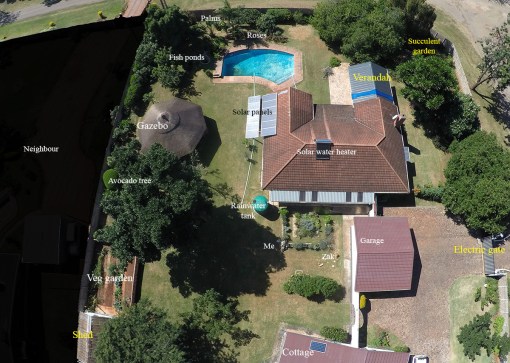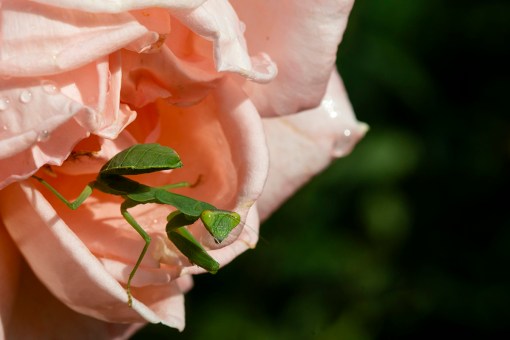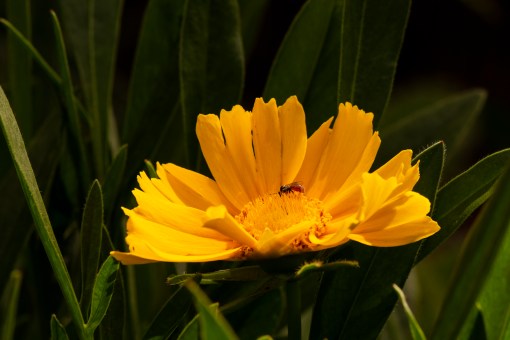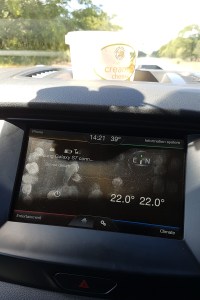
Aerial view of part of our property and house
It is the end of summer as I write this, the rains have come to and early end, and the garden is drying out and losing the vibrant green. The borehole has sadly not recharged enough to offset the previous 2 years of sub-normal rainfall so already we’ve had to start buying in water. This season’s rainfall was about average at just over 700mm so it’s been a good year for the garden.
We have 3 rainwater tanks of 5,000 litres each so for four months over the rainy season we were self-sufficient and the swimming pool has remained full thanks to the water harvesting system from the roof (blue pipes). We are being a bit optimistic by leaving the pipes in place but for the last 2 years we have had significant rain in April. Curiously we have had municipal water this month, albeit only a trickle, it’s been enough to keep the swimming pool topped up to the point where it can be filtered. It’s not to be relied upon as drinkable so it’s just as well that the borehole flow is good enough to supply drinking water.
That’s Zak lying next to the corner of the kitchen garden. He’s my three-legged Rhodesian ridgeback. You can find his blog here. That’s the remains of a cardboard box he’s lying next to – a dog toy. Not his, he’s so over that sort of thing, but Roxy or Tia’s. They are the others in the Roberts’ pack.
The solar panels we added and then upgraded a year after we moved in. It’s a total of 3,300 W which is more than sufficient to power anything we need during sunlight hours and the batteries can easily carry us through overnight if the day has been clear. The mains power supply is notoriously unreliable during the rains which is also the season of most cloud so we make sure we turn the mains on at night, to recharge the batteries, just in case. We use approximately US$1 a day of mains electricity.
The solar water heater is essential for any household in this climate. It’s so efficient that at this time of year the water frequently boils during the day. We do occasionally have to boost the heat with mains during overcast spells but it’s a comparatively rare occurrence – get one if you can.

Fuchsia on the verandah
Fuchsias, ferns and other shade loving plants thrive on the verandah which we added after moving in. The previous owners had zero interest in the garden and the verandah was just a concrete floor and some ugly walls which came down as soon as we had the money. In Zimbabwe we have fantastic weather (contrasted by an equally dismal economy) so it makes sense to spend as much time outside as possible.
Palms were an early acquisition to block out a very ugly electricity supply pylon. They have grown well and mostly fulfilled their purpose.
The veggie garden was also a new development on a vacant piece of the garden previously occupied by the remains of a car port. The garden shed was a car workshop. Veggie gardens are a bit of a luxury given that we have to buy water in and they don’t like waste water as we found out. Still it’s nice to go into the garden and select a succulent broccoli for supper

Mantis on a rose
Most of the roses came with us from the farm. Unfortunately they don’t always get the attention and water they need but can be spectacular.
A swimming pool was not on the list of essentials when were looking for a property. They are nice to have and I use ours regularly in the warmer months but they are a money sink in chemicals and this one leaks which is a pain. Despite lots of excavation and probing I’ve yet to find a leak. It will have a cover on it soon to reduce evaporation.
The avocado tree is a bone of contention. It doesn’t produce very good avocados and I have the means to top work (graft onto the existing tree) some really good quality cultivars. It means that it must be cut back and then for a few years will cast minimal shade. Marianne is allergic to avocados so she’s only in it for the shade but we have plenty of other trees that we planted after moving in (14 though we have cut down 6 that were in poor health) that are shaping up well.

View of the house looking north
Top amongst these is the Acacia (now Vachellia) abyssinica which has grown at least to 8m in the four years we have been here. We didn’t realize that it had been planted in the soak-away from the servants’ quarters and it grew so fast that it its second year it was knocked flat by a strong wind. A strong pole support for a year saw a full recovery and it’s already showing the flat top growth typical of its common name “Nyanga flat-topped acacia”.
The mulberry tree was inherited. It is prolific in production and growth. The latter is easily controlled by pruning and whilst I do really like mulberries, by the end of the season I’ve had enough. There’s only so many one can eat.
If it weren’t for the cottage we probably would not have bought the property. The main house was not in a good state and we gutted it of the lifting parquet flooring, repainted inside and out and re-tiled the bathrooms. The kitchen is still waiting. The house dates from 1960 and was built by a friend’s father and uncle. The cottage is relatively new and was built by the previous owners for their parents. It didn’t need much renovation and we lease it out. We will possibly use it when we retire and rent out the house. That’s a long way off, one doesn’t retire early (or on time by First World standards) in Zimbabwe unless one is financially secure and we are not.
The kitchen garden is the site of an old garden shed in which was stored all nature of old engine oils and unknown substances. We tried using the soil but it had been poisoned so gave up and now everything is in pots or a custom-built flower bed of bricks. It’s home to kitchen herbs, lavender and an assortment of annual flowers.
I’ve always wanted a water feature and so the fish ponds were the result. They were stocked with some small gold fish types and various other fish that I sourced from my friend Gary in the border town of Mutare. There are even some sword-tails that can only have got there by mistake as I didn’t buy them. They are supposedly tropical fish but have proliferated in water that can get quite cold in winter.

A succulent of sorts
The fish ponds are surrounded mainly by aloes and other succulents that are hardy enough to survive with minimal watering. They’d better be hardy as they are not getting much water this coming year.
The main succulent garden (top picture) is situated in a part of the garden that has truly dismal soil. It’s full of aloes and other succulents that must do as they can to survive. Aloes are indigenous to Africa and the Arabian Peninsula so they should be OK. This year they have put on quite a show so far.

A showy cluster of aloe flowers
Sunbirds are nectar feeders and normally love aloe flowers but so far we have seen few. Maybe it’s because the garden has only become colourful relatively recently. We wait and hope.

Cosmos
Cosmos are also left to their own devices in the succulent garden. So far they have managed well. They survive well enough in the wild in the higher rainfall areas of Zimbabwe. Apparently they were introduced in horse feed to South Africa during the Anglo-Boer War. These were snaffled from an uncollected customer’s order at the nursery. One of the perks of being the boss.

Daisy-of-sorts
This is another uncollected order. It’s a daisy of sorts, we’ll see if it has what it takes to survive in the succulent garden.

Hoverfly on a daisy
Perhaps not surprisingly the insect life in the garden is not prolific and yes, I am frequently looking for photo opportunities. This daisy is something of a magnet for hover flies. Superficially resembling a bee it’s known as a bee mimic of which there are several. I do make an effort not to use “heavy” agro-chemicals on the garden to the point that the roses have suffered so I put it down to the newness of the garden.
The lawn is drying off and will in time go completely brown. It isn’t of course dead – come the next rains it will revive remarkably quickly. The kitchen garden will take a knock but be kept going by the waste water from the washing machine. Other ferns and things on the verandah will be kept alive no matter what. We’ll just have to hope the next rainy season is a good one and recharges the borehole but nothing is guaranteed in this part of the world – especially not the weather.

A gazania in the kitchen garden – fate uncertain.
The neighbours – I haven’t mentioned them. The one to the west has a husband who is a retired international cricket umpire. She makes ends meet by growing veggies for restaurants from the seedlings I supply her. We’ve never met the one to the north but I do have his phone number. I cannot show their gardens for privacy reasons but you’ll just have to take my word for it that there’s nothing illegal going on that I could see which was just about everything from the drone’s vantage point.









The end-of-summer garden
11 04 2021Aerial view of part of our property and house
It is the end of summer as I write this, the rains have come to and early end, and the garden is drying out and losing the vibrant green. The borehole has sadly not recharged enough to offset the previous 2 years of sub-normal rainfall so already we’ve had to start buying in water. This season’s rainfall was about average at just over 700mm so it’s been a good year for the garden.
We have 3 rainwater tanks of 5,000 litres each so for four months over the rainy season we were self-sufficient and the swimming pool has remained full thanks to the water harvesting system from the roof (blue pipes). We are being a bit optimistic by leaving the pipes in place but for the last 2 years we have had significant rain in April. Curiously we have had municipal water this month, albeit only a trickle, it’s been enough to keep the swimming pool topped up to the point where it can be filtered. It’s not to be relied upon as drinkable so it’s just as well that the borehole flow is good enough to supply drinking water.
That’s Zak lying next to the corner of the kitchen garden. He’s my three-legged Rhodesian ridgeback. You can find his blog here. That’s the remains of a cardboard box he’s lying next to – a dog toy. Not his, he’s so over that sort of thing, but Roxy or Tia’s. They are the others in the Roberts’ pack.
The solar panels we added and then upgraded a year after we moved in. It’s a total of 3,300 W which is more than sufficient to power anything we need during sunlight hours and the batteries can easily carry us through overnight if the day has been clear. The mains power supply is notoriously unreliable during the rains which is also the season of most cloud so we make sure we turn the mains on at night, to recharge the batteries, just in case. We use approximately US$1 a day of mains electricity.
The solar water heater is essential for any household in this climate. It’s so efficient that at this time of year the water frequently boils during the day. We do occasionally have to boost the heat with mains during overcast spells but it’s a comparatively rare occurrence – get one if you can.
Fuchsia on the verandah
Fuchsias, ferns and other shade loving plants thrive on the verandah which we added after moving in. The previous owners had zero interest in the garden and the verandah was just a concrete floor and some ugly walls which came down as soon as we had the money. In Zimbabwe we have fantastic weather (contrasted by an equally dismal economy) so it makes sense to spend as much time outside as possible.
Palms were an early acquisition to block out a very ugly electricity supply pylon. They have grown well and mostly fulfilled their purpose.
The veggie garden was also a new development on a vacant piece of the garden previously occupied by the remains of a car port. The garden shed was a car workshop. Veggie gardens are a bit of a luxury given that we have to buy water in and they don’t like waste water as we found out. Still it’s nice to go into the garden and select a succulent broccoli for supper
Mantis on a rose
Most of the roses came with us from the farm. Unfortunately they don’t always get the attention and water they need but can be spectacular.
A swimming pool was not on the list of essentials when were looking for a property. They are nice to have and I use ours regularly in the warmer months but they are a money sink in chemicals and this one leaks which is a pain. Despite lots of excavation and probing I’ve yet to find a leak. It will have a cover on it soon to reduce evaporation.
The avocado tree is a bone of contention. It doesn’t produce very good avocados and I have the means to top work (graft onto the existing tree) some really good quality cultivars. It means that it must be cut back and then for a few years will cast minimal shade. Marianne is allergic to avocados so she’s only in it for the shade but we have plenty of other trees that we planted after moving in (14 though we have cut down 6 that were in poor health) that are shaping up well.
View of the house looking north
Top amongst these is the Acacia (now Vachellia) abyssinica which has grown at least to 8m in the four years we have been here. We didn’t realize that it had been planted in the soak-away from the servants’ quarters and it grew so fast that it its second year it was knocked flat by a strong wind. A strong pole support for a year saw a full recovery and it’s already showing the flat top growth typical of its common name “Nyanga flat-topped acacia”.
The mulberry tree was inherited. It is prolific in production and growth. The latter is easily controlled by pruning and whilst I do really like mulberries, by the end of the season I’ve had enough. There’s only so many one can eat.
If it weren’t for the cottage we probably would not have bought the property. The main house was not in a good state and we gutted it of the lifting parquet flooring, repainted inside and out and re-tiled the bathrooms. The kitchen is still waiting. The house dates from 1960 and was built by a friend’s father and uncle. The cottage is relatively new and was built by the previous owners for their parents. It didn’t need much renovation and we lease it out. We will possibly use it when we retire and rent out the house. That’s a long way off, one doesn’t retire early (or on time by First World standards) in Zimbabwe unless one is financially secure and we are not.
Sabi Star or Impala Lily (it’s not a lily)
The kitchen garden is the site of an old garden shed in which was stored all nature of old engine oils and unknown substances. We tried using the soil but it had been poisoned so gave up and now everything is in pots or a custom-built flower bed of bricks. It’s home to kitchen herbs, lavender and an assortment of annual flowers.
I’ve always wanted a water feature and so the fish ponds were the result. They were stocked with some small gold fish types and various other fish that I sourced from my friend Gary in the border town of Mutare. There are even some sword-tails that can only have got there by mistake as I didn’t buy them. They are supposedly tropical fish but have proliferated in water that can get quite cold in winter.
A succulent of sorts
The fish ponds are surrounded mainly by aloes and other succulents that are hardy enough to survive with minimal watering. They’d better be hardy as they are not getting much water this coming year.
The main succulent garden (top picture) is situated in a part of the garden that has truly dismal soil. It’s full of aloes and other succulents that must do as they can to survive. Aloes are indigenous to Africa and the Arabian Peninsula so they should be OK. This year they have put on quite a show so far.
A showy cluster of aloe flowers
Sunbirds are nectar feeders and normally love aloe flowers but so far we have seen few. Maybe it’s because the garden has only become colourful relatively recently. We wait and hope.
Cosmos
Cosmos are also left to their own devices in the succulent garden. So far they have managed well. They survive well enough in the wild in the higher rainfall areas of Zimbabwe. Apparently they were introduced in horse feed to South Africa during the Anglo-Boer War. These were snaffled from an uncollected customer’s order at the nursery. One of the perks of being the boss.
Daisy-of-sorts
This is another uncollected order. It’s a daisy of sorts, we’ll see if it has what it takes to survive in the succulent garden.
Hoverfly on a daisy
Perhaps not surprisingly the insect life in the garden is not prolific and yes, I am frequently looking for photo opportunities. This daisy is something of a magnet for hover flies. Superficially resembling a bee it’s known as a bee mimic of which there are several. I do make an effort not to use “heavy” agro-chemicals on the garden to the point that the roses have suffered so I put it down to the newness of the garden.
The lawn is drying off and will in time go completely brown. It isn’t of course dead – come the next rains it will revive remarkably quickly. The kitchen garden will take a knock but be kept going by the waste water from the washing machine. Other ferns and things on the verandah will be kept alive no matter what. We’ll just have to hope the next rainy season is a good one and recharges the borehole but nothing is guaranteed in this part of the world – especially not the weather.
A gazania in the kitchen garden – fate uncertain.
The neighbours – I haven’t mentioned them. The one to the west has a husband who is a retired international cricket umpire. She makes ends meet by growing veggies for restaurants from the seedlings I supply her. We’ve never met the one to the north but I do have his phone number. I cannot show their gardens for privacy reasons but you’ll just have to take my word for it that there’s nothing illegal going on that I could see which was just about everything from the drone’s vantage point.
Comments : 6 Comments »
Tags: avocado, fuschia, mantis, rains, Zak
Categories : flowers, News & Various, photography, Social commentary